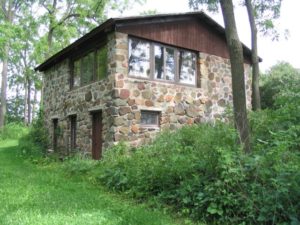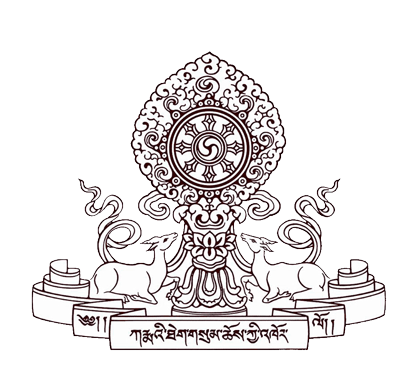Environmentally friendly features of the Hay River KTC Center building and house
Construction of center
 The exterior walls are constructed with field stone, gathered from the local farm fields, and concrete. Some of the pine boards used in construction came from local trees that were sawn into boards and planed locally. The main roof is supported by four trusses made from 4×6 oak beams harvested from Lama Yeshe’s sustainably managed woods. The interior woodwork around the windows, doors and so forth are also made of oak from Lama Yeshe’s woods.
The exterior walls are constructed with field stone, gathered from the local farm fields, and concrete. Some of the pine boards used in construction came from local trees that were sawn into boards and planed locally. The main roof is supported by four trusses made from 4×6 oak beams harvested from Lama Yeshe’s sustainably managed woods. The interior woodwork around the windows, doors and so forth are also made of oak from Lama Yeshe’s woods.
The house
 The house is used for meals, gatherings and overnight lodging. It was built around 1890. Lama Yeshe has lived there since 1971. In that time various projects were done for energy efficiency. Insulation was added to the attic and to the roof where there is heated space under the roof. Wall insulation was added to what had been blown in by earlier occupants when necessary. All the old original windows are replaced with low E insulated glass windows. Most of the siding has been replaced and has a sheet of house wrap under it to reduce infiltration of outside air. Being an old house this has helped reduce infiltration but not eliminated. Much of the woodwork in the house, including the kitchen cabinets, comes from wood sustainably harvested from Lama Yeshe’s woods.
The house is used for meals, gatherings and overnight lodging. It was built around 1890. Lama Yeshe has lived there since 1971. In that time various projects were done for energy efficiency. Insulation was added to the attic and to the roof where there is heated space under the roof. Wall insulation was added to what had been blown in by earlier occupants when necessary. All the old original windows are replaced with low E insulated glass windows. Most of the siding has been replaced and has a sheet of house wrap under it to reduce infiltration of outside air. Being an old house this has helped reduce infiltration but not eliminated. Much of the woodwork in the house, including the kitchen cabinets, comes from wood sustainably harvested from Lama Yeshe’s woods.
Heating, cooling and energy use
The shrine room building has a first floor and a walk out basement. About 60% of
 the basement is underground which moderates both heat and cold temperatures. The walls of the building are 10 inches thick and made of stone and concrete. The walls are insulated on the inside with 3 1/2 inches of fiberglass. The vaulted ceiling keeps heat in the summer away from the occupants. The total area of glass on the south side is about 12 feet by 4 feet. In the summer the roof overhang keeps the sun from reaching into the room on the longest day, June 21st, preventing heat entering the building. By the shortest day, December 21st, the sunlight reaches 18 feet into the room providing heat. On the west side there are deciduous trees which provide cooling shade from late May to the end of September and then let in the full sun in the late afternoon during the colder months when the leaves are gone. There is about 10 feet by 4 feet of glass on this side. When the shrine room building is not being used, the temperature is kept at 50 degrees which reduces energy use in the winter. On sunny days in winter it warms up as much as 20 degrees due to solar gain. Then it takes time before cooling down to 50 and heat is needed. The windows allow a lot of sunlight in, minimizing the need for artificial light during the day.
the basement is underground which moderates both heat and cold temperatures. The walls of the building are 10 inches thick and made of stone and concrete. The walls are insulated on the inside with 3 1/2 inches of fiberglass. The vaulted ceiling keeps heat in the summer away from the occupants. The total area of glass on the south side is about 12 feet by 4 feet. In the summer the roof overhang keeps the sun from reaching into the room on the longest day, June 21st, preventing heat entering the building. By the shortest day, December 21st, the sunlight reaches 18 feet into the room providing heat. On the west side there are deciduous trees which provide cooling shade from late May to the end of September and then let in the full sun in the late afternoon during the colder months when the leaves are gone. There is about 10 feet by 4 feet of glass on this side. When the shrine room building is not being used, the temperature is kept at 50 degrees which reduces energy use in the winter. On sunny days in winter it warms up as much as 20 degrees due to solar gain. Then it takes time before cooling down to 50 and heat is needed. The windows allow a lot of sunlight in, minimizing the need for artificial light during the day.
There are solar electric panels on the roof of the shrine room building. They  generate electricity that we use, and the excess production is fed into the power grid. The excess electricity is bought by the utility company. Both the house and the Center are on the same ‘time of use’ electric meter. The local utility has a program to lower peak load and therefore reduce the need for building new power plants and more power transmission lines. This program allows them to turn off the electric hot water heater, 7:30am to 7:30pm, Monday through Friday except for holidays. They give us a lower rate for electricity during off peak hours, which more than offsets the higher rate for on peak electricity and saves the center money. The electric bill for both the house and the center averages about $55 a month. Liquified propane is used in the house for cooking, clothes drying and heat for the house. It runs about 800-900 gallons a year. The Shrine Room uses about 300-350 gallons a year. Both buildings use LED lights.
generate electricity that we use, and the excess production is fed into the power grid. The excess electricity is bought by the utility company. Both the house and the Center are on the same ‘time of use’ electric meter. The local utility has a program to lower peak load and therefore reduce the need for building new power plants and more power transmission lines. This program allows them to turn off the electric hot water heater, 7:30am to 7:30pm, Monday through Friday except for holidays. They give us a lower rate for electricity during off peak hours, which more than offsets the higher rate for on peak electricity and saves the center money. The electric bill for both the house and the center averages about $55 a month. Liquified propane is used in the house for cooking, clothes drying and heat for the house. It runs about 800-900 gallons a year. The Shrine Room uses about 300-350 gallons a year. Both buildings use LED lights.
Furnishings
 The Puja tables and throne in the shrine room are made from trees from Lama Yeshe’s sustainably managed woods. All the furniture in the house is used, not new. Used furniture uses no resources except for transportation. Some are antiques, some are just used. The upholstered furniture Lama Yeshe rebuilt and recovered. There is plenty of very good quality used furniture available at garage sales, antique stores, Ebay, Craig’s List and so forth. The cook stove in the house is gas and was made in the 1920’s. New, energy efficient appliances are used elsewhere in the house.
The Puja tables and throne in the shrine room are made from trees from Lama Yeshe’s sustainably managed woods. All the furniture in the house is used, not new. Used furniture uses no resources except for transportation. Some are antiques, some are just used. The upholstered furniture Lama Yeshe rebuilt and recovered. There is plenty of very good quality used furniture available at garage sales, antique stores, Ebay, Craig’s List and so forth. The cook stove in the house is gas and was made in the 1920’s. New, energy efficient appliances are used elsewhere in the house.
Green Initiatives: Sustainable woodland management
The Karmapa encourages woodland management because trees are so beneficial. They process our exhaled carbon dioxide and covert it into carbon in the wood, and oxygen which is essential for us to breath. Trees prevent erosion, slow down the process of rainfall entering rivers, release moisture into the air which then becomes rain, provide habitat for a wide variety of wildlife, provide fuel, building material, even food There are about 5 acres of trees on the 13 acres the house and shrine room building are on.

Woodland management of the woods on the 13 acres
The 5 acres has walnut, oak, birch, white ash, a few poplar, maple and box elder trees. The oak are mature and reaching the end of their life. Some that have little value as saw logs are allowed to die naturally and then they become firewood. Or some times cut into firewood before they are completely dead. Those would make high grade lumber are harvested selectively from time to time and the boards used on the property or saved for future use. Conditions are not good for the regeneration of young oaks so nothing has been done to plant new oaks. I harvest the walnut trees selectively, choosing those that: 1. have a flaw that would cause them to rot or deteriorate, 2. have other trees close that need room to grow, 3. are too close to a building. The walnuts do regenerate with the help of squirrels and there are many young walnut trees of different ages. I have planted a few walnut trees over the years but squirrels will plant nuts and they are very diligent. So I let them do the planting. There are some 35 year old walnut trees that are over 50 feet high. In order for a woods to be healthy there needs to be a mix of young, middle age and old trees. I am encouraging trees to grow on land that did not have trees in the recent past so the 5 acres is growing to 6. Oak is a beautiful wood when made into trim, furniture and so forth, Walnut is even more beautiful.


Recycling
We recycle glass, plastic, aluminum, shopping bags. Paper, cardboard, magazines and scrap wood are used for heat in the outdoor wood boiler.
